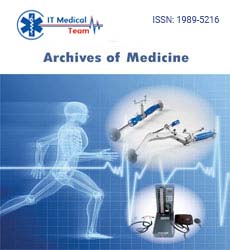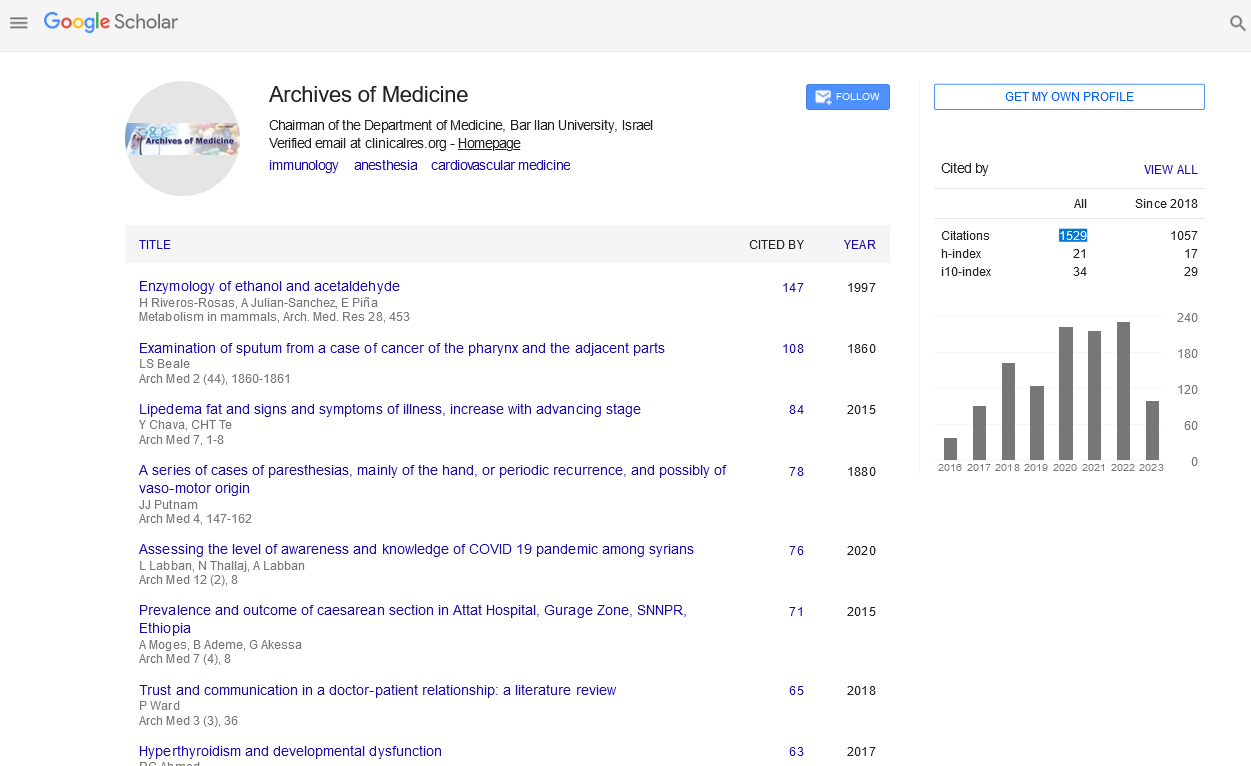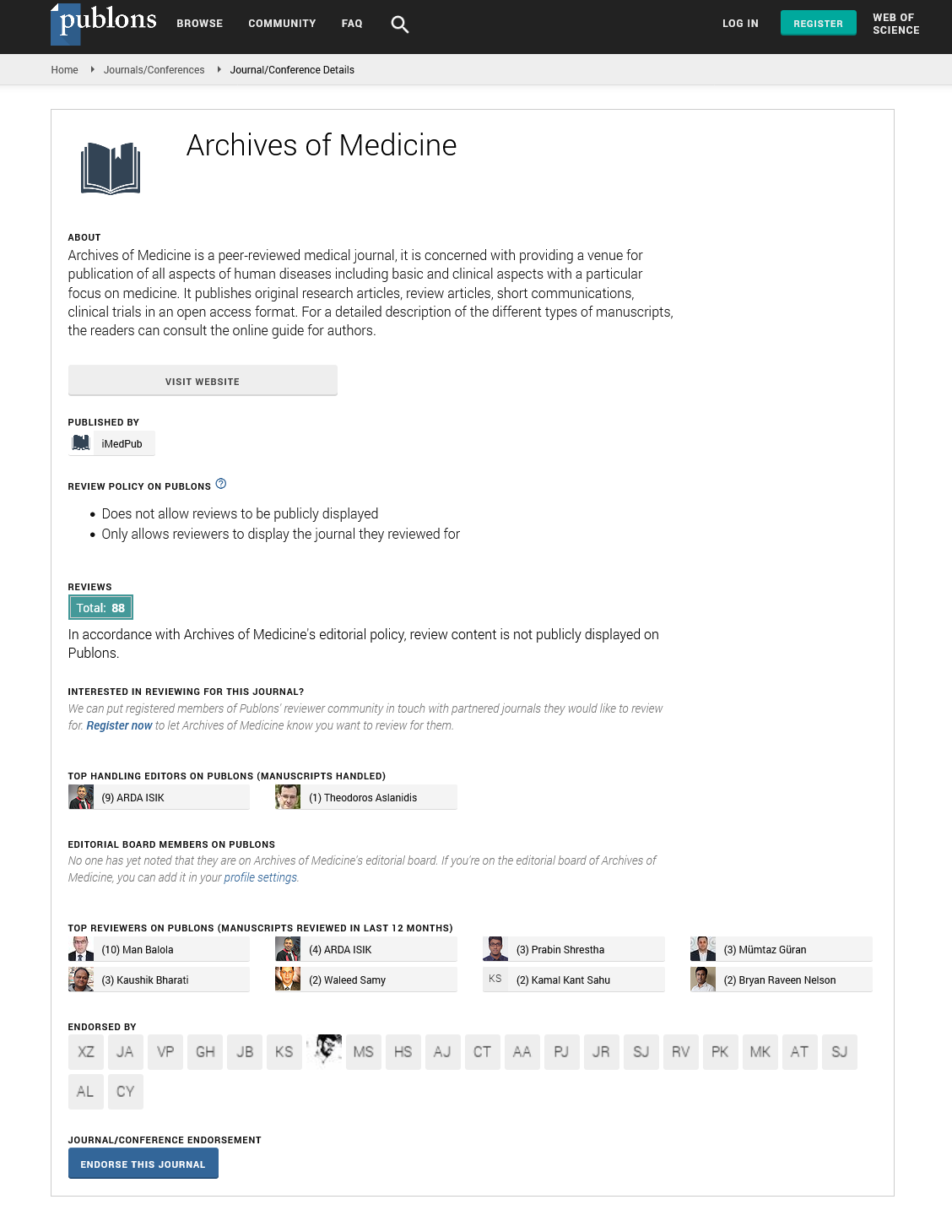Commentary - (2023) Volume 15, Issue 3
Respiratory medicine: Understanding and treating respiratory diseases
Xinhua Liu*
Department of Medicine, University of Porto, Porto, Portugal
*Correspondence:
Xinhua Liu, Department of Medicine, University of Porto, Porto,
Portugal,
Email:
Received: 01-May-2023, Manuscript No. ipaom-23-13738;
Editor assigned: 03-May-2023, Pre QC No. P-13738;
Reviewed: 15-May-2023, QC No. Q-13738;
Revised: 20-May-2023, Manuscript No. R-13738;
Published:
27-May-2023
Description
Respiratory medicine, also known as pulmonology,
is a medical specialty that focuses on the diagnosis and
treatment of diseases and conditions that affect the
respiratory system. The respiratory system includes organs
such as the nose, throat, lungs, and diaphragm, which
work together to facilitate breathing and exchange of gases,
such as oxygen and carbon dioxide, between the body
and the external environment. Respiratory diseases can
range from acute infections, such as the common cold, to
chronic conditions, such as asthma and chronic obstructive
pulmonary disease (COPD), which can significantly
impact a person's quality of life [1].
Respiratory diseases are prevalent worldwide and can
affect individuals of all ages. According to the World Health
Organization (WHO), respiratory diseases are responsible
for millions of deaths each year, making them a significant
global health concern. Respiratory medicine plays a crucial
role in diagnosing and managing these diseases to improve
patient outcomes and overall respiratory health.
The diagnosis of respiratory diseases typically involves
a comprehensive evaluation that includes taking a detailed
medical history, conducting a physical examination,
and ordering various tests. Medical history may involve
questions about symptoms, exposure to risk factors such
as smoking or environmental pollutants, and family
history of respiratory diseases. A physical examination may
involve listening to the lungs with a stethoscope to detect
abnormal breath sounds, examining the nose and throat,
and evaluating overall respiratory function [2].
In addition to the medical history and physical
examination, respiratory function tests are commonly used
to assess lung function. These tests may include spirometry,
which measures the volume and speed of air that can be
exhaled from the lungs, and other specialized tests, such
as lung diffusion capacity and bronchial provocation
tests. Imaging studies, such as chest X-rays, computed
tomography (CT) scans, and magnetic resonance imaging
(MRI), may also be used to visualize the respiratory organs
and assess the extent and severity of respiratory diseases [3].
Asthma: Asthma is a chronic condition that affects the
airways, causing them to narrow and become inflamed,
leading to symptoms such as wheezing, coughing, shortness
of breath, and chest tightness. Treatment for asthma
typically involves the use of inhaled bronchodilators,
which help to open the airways and reduce inflammation,
and corticosteroids, which help to reduce inflammation in the airways. Long-term management may also involve
identifying and avoiding triggers, such as allergens or
irritants, and creating an asthma action plan for monitoring
and controlling symptoms. Chronic Obstructive Pulmonary
Disease (COPD): COPD is a group of chronic lung diseases,
including chronic bronchitis and emphysema, that cause
airflow limitation and breathing difficulties. Treatment
for COPD may include bronchodilators, corticosteroids,
oxygen therapy, pulmonary rehabilitation, and lifestyle
changes such as quitting smoking and avoiding exposure to
pollutants. In severe cases, advanced interventions such as
lung transplantation may be considered [4].
Pneumonia: Pneumonia is an infection that affects the
lungs and can be caused by various microorganisms, such
as bacteria, viruses, and fungi. Treatment for pneumonia
depends on the causative organism and the severity of the
infection, and may involve antibiotics, antiviral drugs, or
antifungal medications. Supportive care, such as oxygen
therapy, may also be provided to help manage symptoms
and improve respiratory function.
Sleep apnea: Sleep apnea is a condition characterized
by pauses in breathing during sleep, often due to partial
or complete obstruction of the airway. Treatment for sleep
apnea may involve lifestyle changes such as weight loss,
positional therapy, and avoiding alcohol and sedatives
before bedtime. Continuous positive airway pressure
(CPAP) therapy, which involves wearing a mask over the
nose or nose and mouth during sleep to deliver pressurized
air to help keep the airway open, is a common treatment
for sleep apnea. Other treatment options may include
oral appliances, which are devices worn in the mouth to
help keep the airway open, and in some cases, surgery to
remove excess tissue or correct structural abnormalities in
the airway.
Lung cancer: Lung cancer is a malignant tumor that
originates in the lungs and can spread to other parts of
the body. Treatment for lung cancer depends on the stage,
location, and type of cancer, as well as the overall health
of the patient. Treatment options may include surgery,
radiation therapy, chemotherapy, targeted therapy, and
immunotherapy. Multidisciplinary approaches involving
a team of healthcare professionals, including respiratory
physicians, oncologists, surgeons, and radiation oncologists,
are often used to provide personalized and comprehensive
care for lung cancer patients.
Pulmonary embolism: Pulmonary embolism is a
condition where a blood clot travels to the lungs and
blocks the pulmonary arteries, causing reduced blood flow
to the lungs. Treatment for pulmonary embolism may
involve anticoagulant medications to prevent further clot
formation, thrombolytic therapy to dissolve the blood clot,
and in some cases, surgical interventions to remove the
clot. Respiratory physicians play a vital role in the diagnosis
and management of pulmonary embolism, as they can
help determine the severity of the condition and provide
appropriate treatment options.
Respiratory medicine is a critical specialty that focuses
on the diagnosis and treatment of respiratory diseases,
which can significantly impact a person's health and quality
of life. From asthma and COPD to pneumonia, sleep
apnea, lung cancer, and pulmonary embolism, respiratory
physicians play a crucial role in evaluating and managing
these conditions. Early diagnosis, proper treatment, and
ongoing management can help improve outcomes and
enhance the respiratory health of patients [5].
Conclusion
If you are experiencing respiratory symptoms such as
persistent coughing, shortness of breath, wheezing, or chest
pain, it is essential to consult a healthcare professional,
particularly a respiratory physician, for proper evaluation
and management. Proper management of respiratory
diseases may involve a combination of medications, lifestyle
changes, and supportive care, tailored to the individual
needs of each patient. Respiratory physicians are trained
to provide comprehensive care and work collaboratively
with other healthcare professionals to ensure optimal
management of respiratory diseases, ultimately helping
patients lead healthier and more fulfilling lives.
Acknowledgement
None.
Conflict of Interest
None.
References
- JL IA, JM RG. Pneumology in the Days of COVID-19. Arch Bronconeumol. 2020;56:1-2.
Google Scholar, Indexed at, Indexed at
- Nathan RA, Sorkness CA, Kosinski M, et al. Development of the asthma control test: A survey for assessing asthma control. J Allergy Clin Immunol. 2004;113(1):59-65.
Google Scholar, Indexed at, Indexed at
- Almonacid C, Blanco-Aparicio M, Domínguez-Ortega J, et al. Teleconsultation in the follow-up of the asthma patient. Arch Bronconeumol. 2020;57:13-14.
Google Scholar, Indexed at, Indexed at
- Cottrell MA, Russell TG. Telehealth for musculoskeletal physiotherapy. Musculoskelet Sci Pract. 2020;48:102193.
Google Scholar, Indexed at, Indexed at
- Windisch W, Freidel K, Schucher B, et al. The Severe Respiratory Insufficiency (SRI) Questionnaire A specific measure of health-related quality of life in patients receiving home mechanical ventilation. J Clin Epidemiol. 2003;56(8):752-759.
Google Scholar, Indexed at, Indexed at






